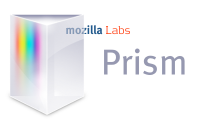Chromeless or Chrome?
We have often the impression that Mozilla's developments
are headed by opportunities that they discover by chance in
programs that are being developed, rather than a well-established plan.
This was the case with XUL that firstly was just the interface of Mozilla, and
which has found opportunities as a universal GUI, and it is also the case
with Chromeless (formerly Webrunner and then Prism), a very streamlined version of Firefox
running Web applications locally.
Could Chromeless be an alternative to Chrome, the browser Google deliberately designed for Web applications?
Prism/Chromeless
 Prism, nom included in Chromeless, is a modified version of Firefox to use RIA (Rich Internet Application) on the desktop. It has dropped features specific to Web browsing.
Prism, nom included in Chromeless, is a modified version of Firefox to use RIA (Rich Internet Application) on the desktop. It has dropped features specific to Web browsing.
It does not run only XUL applications but all those that are compatible with common browsers. However, Chromeless supports same technologies than Firefox, which
includes Canvas, a good way to define graphical components, and some parts of HTML 5, a format designed for web applications. Canvas3D will soon complement these features for applications requiring a graphics accelerator.
Chromeless has a full-screen mode that hides the browser interface to make room for the application.
The TraceMonkey JavaScript compiler that appears with Firefox 3.1 is designed to run JavaScript much faster, thus eliminating any reluctance to use graphical interface frameworks and create sites closer to local applications.
Chrome
 Unlike Prism, Chrome has been designed from the outset to run rich Internet applications. The main
feature of this browser is the presence of tabs that correspond to Web
pages or online applications, each operating in its own environment. It has its resources, its own memory and the problems of one do not affect others.
Unlike Prism, Chrome has been designed from the outset to run rich Internet applications. The main
feature of this browser is the presence of tabs that correspond to Web
pages or online applications, each operating in its own environment. It has its resources, its own memory and the problems of one do not affect others.
Chrome also has a sleek interface although this hides many functions. The space is almost entirely occupied by the application that you can also show in full screen.
Finally Chrome has the V8 JavaScript compiler that powers the code 20 to 40 times faster than conventional interpreters.
On a more RIA aspect, Chrome includes built-in Google Gear to run offline Web applications, uses SQLite as local database and Silverlight, a graphical interface framework based on XAML.
But it did not for now (in 2008) support Canvas and other elements defined in HTML 5 as audio and video.
Conclusion
Google says that in releasing Chrome, the intention is not to take
market share, but to encourage authors of browsers to rethink their
design to adapt it to new Web applications that could work on the local
desktop.
However, Firefox provides through plugins (including Gears and Silverlight) and extensions, much of what
is necessary and even more than Chrome with the support of HTML 5. Chromeless has a speed of loading that Firefox does not have, the only remaining advantage to Chrome being encapsulation of applications.
Chromeless and Chrome have the same interests for the user, no need to install software and updates and the ability to use its tools everywhere. Both are the future of the workplace.



